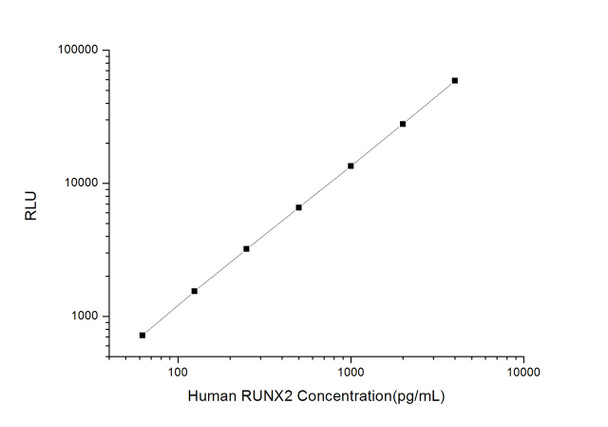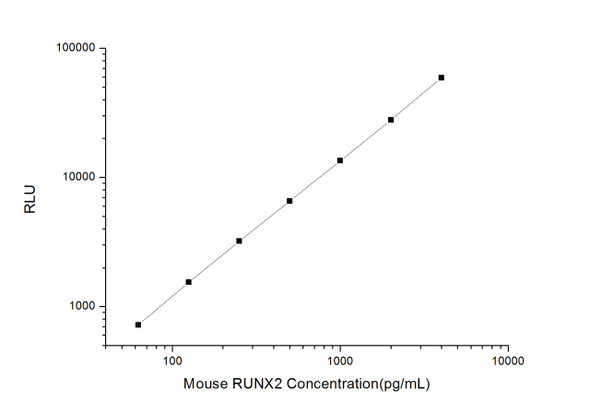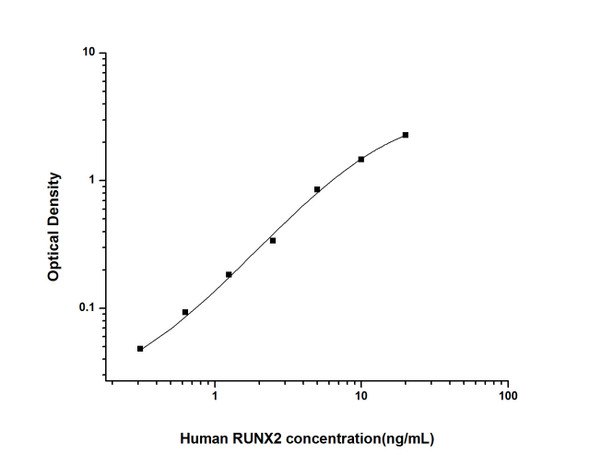Human Developmental Biology ELISA Kits
Human RUNX2 (Runt-Related Transcription Factor 2) CLIA Kit (HUES00550)
- SKU:
- HUES00550
- Product Type:
- ELISA Kit
- ELISA Type:
- CLIA Kit
- Size:
- 96 Assays
- Sensitivity:
- 37.5pg/mL
- Range:
- 62.5-4000pg/mL
- ELISA Type:
- Sandwich
- Synonyms:
- AML3, CBFA1, CCD, CCD1, OSF2, PEA2aA, PEBP2A1, PEBP2A2, PEBP2aA, PEBP2aA1
- Reactivity:
- Human
- Sample Type:
- Serum, plasma and other biological fluids
- Research Area:
- Developmental Biology
Description
| Assay type: | Sandwich |
| Format: | 96T |
| Assay time: | 4.5h |
| Reactivity: | Human |
| Detection method: | Chemiluminescence |
| Detection range: | 62.50-4000 pg/mL |
| Sensitivity: | 37.50 pg/mL |
| Sample volume: | 100µL |
| Sample type: | Serum, plasma and other biological fluids |
| Repeatability: | CV < 15% |
| Specificity: | This kit recognizes Human RUNX2 in samples. No significant cross-reactivity or interference between Human RUNX2 and analogues was observed. |
This kit uses Sandwich-CLIA as the method. The micro CLIA plate provided in this kit has been pre-coated with an antibody specific to Human RUNX2. Standards or samples are added to the appropriate micro CLIA plate wells and combined with the specific antibody. Then a biotinylated detection antibody specific for Human RUNX2 and Avidin-Horseradish Peroxidase (HRP) conjugate are added to each micro plate well successively and incubated. Free components are washed away. The substrate solution is added to each well. Only those wells that contain Human RUNX2, biotinylated detection antibody and Avidin-HRP conjugate will appear fluorescence. The Relative light unit (RLU) value is measured spectrophotometrically by the Chemiluminescence immunoassay analyzer. The RLU value is positively associated with the concentration of Human RUNX2. The concentration of Human RUNX2 in the samples can be calculated by comparing the RLU of the samples to the standard curve.
| UniProt Protein Function: | AML3: Transcription factor involved in osteoblastic differentiation and skeletal morphogenesis. Essential for the maturation of osteoblasts and both intramembranous and endochondral ossification. CBF binds to the core site, 5'- PYGPYGGT-3', of a number of enhancers and promoters, including murine leukemia virus, polyomavirus enhancer, T-cell receptor enhancers, osteocalcin, osteopontin, bone sialoprotein, alpha 1(I) collagen, LCK, IL-3 and GM-CSF promoters. In osteoblasts, supports transcription activation: synergizes with SPEN/MINT to enhance FGFR2-mediated activation of the osteocalcin FGF-responsive element (OCFRE). Inhibits KAT6B-dependent transcriptional activation. Interaction with SATB2 results in enhanced DNA binding and transactivation by these transcription factors. Heterodimer of an alpha and a beta subunit. Interacts with HIVEP3 and HIPK3. The alpha subunit binds DNA as a monomer and through the Runt domain. DNA-binding is increased by heterodimerization. Interacts with XRCC6 (Ku70) and XRCC5 (Ku80). Interacts with KAT6A and KAT6B. Binds to cyclin B1 CCNB1. Interacts with DDX5. Specifically expressed in osteoblasts. 3 isoforms of the human protein are produced by alternative splicing. |
| UniProt Protein Details: | Protein type:Transcription factor; DNA-binding Chromosomal Location of Human Ortholog: 6p21 Cellular Component: nucleoplasm; transcription factor complex; cytoplasm; nuclear chromatin Molecular Function:protein domain specific binding; protein binding; bHLH transcription factor binding; chromatin binding; transcription factor activity; ATP binding Biological Process: embryonic forelimb morphogenesis; transcription initiation from RNA polymerase II promoter; ossification; positive regulation of transcription, DNA-dependent; cell maturation; regulation of fibroblast growth factor receptor signaling pathway; chondrocyte development; embryonic cranial skeleton morphogenesis; stem cell differentiation; osteoblast development; odontogenesis of dentine-containing teeth; BMP signaling pathway; osteoblast differentiation; positive regulation of osteoblast differentiation; positive regulation of chondrocyte differentiation; negative regulation of smoothened signaling pathway; positive regulation of cell proliferation; gene expression; negative regulation of transcription, DNA-dependent; regulation of odontogenesis of dentine-containing teeth; osteoblast fate commitment; T cell differentiation; endochondral ossification Disease: Metaphyseal Dysplasia With Maxillary Hypoplasia With Or Without Brachydactyly; Cleidocranial Dysplasia |
| NCBI Summary: | This gene is a member of the RUNX family of transcription factors and encodes a nuclear protein with an Runt DNA-binding domain. This protein is essential for osteoblastic differentiation and skeletal morphogenesis and acts as a scaffold for nucleic acids and regulatory factors involved in skeletal gene expression. The protein can bind DNA both as a monomer or, with more affinity, as a subunit of a heterodimeric complex. Two regions of potential trinucleotide repeat expansions are present in the N-terminal region of the encoded protein, and these and other mutations in this gene have been associated with the bone development disorder cleidocranial dysplasia (CCD). Transcript variants that encode different protein isoforms result from the use of alternate promoters as well as alternate splicing. [provided by RefSeq, Jul 2016] |
| UniProt Code: | Q13950 |
| NCBI GenInfo Identifier: | 17368460 |
| NCBI Gene ID: | 860 |
| NCBI Accession: | Q13950. 2 |
| UniProt Related Accession: | Q13950 |
| Molecular Weight: | 56. 6kDa |
| NCBI Full Name: | Runt-related transcription factor 2 |
| NCBI Synonym Full Names: | RUNX family transcription factor 2 |
| NCBI Official Symbol: | RUNX2 |
| NCBI Official Synonym Symbols: | CCD; AML3; CCD1; CLCD; OSF2; CBFA1; OSF-2; PEA2aA; PEBP2aA; CBF-alpha-1 |
| NCBI Protein Information: | runt-related transcription factor 2 |
| UniProt Protein Name: | Runt-related transcription factor 2 |
| UniProt Synonym Protein Names: | Acute myeloid leukemia 3 protein; Core-binding factor subunit alpha-1; CBF-alpha-1; Oncogene AML-3; Osteoblast-specific transcription factor 2; OSF-2; Polyomavirus enhancer-binding protein 2 alpha A subunit; PEA2-alpha A; PEBP2-alpha A; SL3-3 enhancer factor 1 alpha A subunit; SL3/AKV core-binding factor alpha A subunit |
| Protein Family: | Runt-related transcription factor |
| UniProt Gene Name: | RUNX2 |
| UniProt Entry Name: | RUNX2_HUMAN |
As the RLU values of the standard curve may vary according to the conditions of the actual assay performance (e. g. operator, pipetting technique, washing technique or temperature effects), the operator should establish a standard curve for each test. Typical standard curve and data is provided below for reference only.
| Concentration (pg/mL) | RLU | Average | Corrected |
| 4000 | 54506 63656 | 59081 | 59046 |
| 2000 | 25793 29925 | 27859 | 27824 |
| 1000 | 14316 12652 | 13484 | 13449 |
| 500 | 6472 6738 | 6605 | 6570 |
| 250 | 3257 3229 | 3243 | 3208 |
| 125 | 1656 1506 | 1581 | 1546 |
| 62.50 | 741 769 | 755 | 720 |
| 0 | 35 35 | 35 | -- |
Precision
Intra-assay Precision (Precision within an assay): 3 samples with low, mid range and high level Human RUNX2 were tested 20 times on one plate, respectively.
Inter-assay Precision (Precision between assays): 3 samples with low, mid range and high level Human RUNX2 were tested on 3 different plates, 20 replicates in each plate.
| Intra-assay Precision | Inter-assay Precision | |||||
| Sample | 1 | 2 | 3 | 1 | 2 | 3 |
| n | 20 | 20 | 20 | 20 | 20 | 20 |
| Mean (pg/mL) | 187.29 | 435.85 | 1445.33 | 176.64 | 430.22 | 1567.02 |
| Standard deviation | 15.73 | 31.69 | 157.83 | 21.09 | 39.80 | 122.54 |
| C V (%) | 8.40 | 7.27 | 10.92 | 11.94 | 9.25 | 7.82 |
Recovery
The recovery of Human RUNX2 spiked at three different levels in samples throughout the range of the assay was evaluated in various matrices.
| Sample Type | Range (%) | Average Recovery (%) |
| Serum (n=5) | 89-101 | 95 |
| EDTA plasma (n=5) | 99-115 | 105 |
| Cell culture media (n=5) | 90-103 | 98 |
Linearity
Samples were spiked with high concentrations of Human RUNX2 and diluted with Reference Standard & Sample Diluent to produce samples with values within the range of the assay.
| Serum (n=5) | EDTA plasma (n=5) | Cell culture media (n=5) | ||
| 1:2 | Range (%) | 98-115 | 98-113 | 98-113 |
| Average (%) | 106 | 106 | 104 | |
| 1:4 | Range (%) | 89-105 | 101-115 | 99-116 |
| Average (%) | 96 | 109 | 106 | |
| 1:8 | Range (%) | 87-98 | 100-114 | 90-103 |
| Average (%) | 93 | 106 | 95 | |
| 1:16 | Range (%) | 95-110 | 93-107 | 91-107 |
| Average (%) | 101 | 99 | 98 |
An unopened kit can be stored at 4°C for 1 month. If the kit is not used within 1 month, store the items separately according to the following conditions once the kit is received.
| Item | Specifications | Storage |
| Micro CLIA Plate(Dismountable) | 8 wells ×12 strips | -20°C, 6 months |
| Reference Standard | 2 vials | |
| Concentrated Biotinylated Detection Ab (100×) | 1 vial, 120 µL | |
| Concentrated HRP Conjugate (100×) | 1 vial, 120 µL | -20°C(shading light), 6 months |
| Reference Standard & Sample Diluent | 1 vial, 20 mL | 4°C, 6 months |
| Biotinylated Detection Ab Diluent | 1 vial, 14 mL | |
| HRP Conjugate Diluent | 1 vial, 14 mL | |
| Concentrated Wash Buffer (25×) | 1 vial, 30 mL | |
| Substrate Reagent A | 1 vial, 5 mL | 4°C (shading light) |
| Substrate Reagent B | 1 vial, 5 mL | 4°C (shading light) |
| Plate Sealer | 5 pieces | |
| Product Description | 1 copy | |
| Certificate of Analysis | 1 copy |
- Set standard, test sample and control (zero) wells on the pre-coated plate and record theirpositions. It is recommended to measure each standard and sample in duplicate. Note: addall solutions to the bottom of the plate wells while avoiding contact with the well walls. Ensuresolutions do not foam when adding to the wells.
- Aliquot 100µl of standard solutions into the standard wells.
- Add 100µl of Sample / Standard dilution buffer into the control (zero) well.
- Add 100µl of properly diluted sample (serum, plasma, tissue homogenates and otherbiological fluids. ) into test sample wells.
- Cover the plate with the sealer provided in the kit and incubate for 90 min at 37°C.
- Aspirate the liquid from each well, do not wash. Immediately add 100µL of BiotinylatedDetection Ab working solution to each well. Cover the plate with a plate seal and gently mix. Incubate for 1 hour at 37°C.
- Aspirate or decant the solution from the plate and add 350µL of wash buffer to each welland incubate for 1-2 minutes at room temperature. Aspirate the solution from each well andclap the plate on absorbent filter paper to dry. Repeat this process 3 times. Note: a microplatewasher can be used in this step and other wash steps.
- Add 100µL of HRP Conjugate working solution to each well. Cover with a plate seal andincubate for 30 min at 37°C.
- Aspirate or decant the solution from each well. Repeat the wash process for five times asconducted in step 7.
- Add 100µL of Substrate mixture solution to each well. Cover with a new plate seal andincubate for no more than 5 min at 37°C. Protect the plate from light.
- Determine the RLU value of each well immediately.






